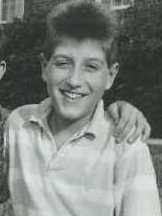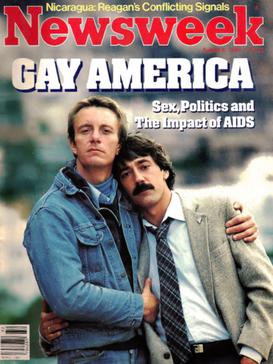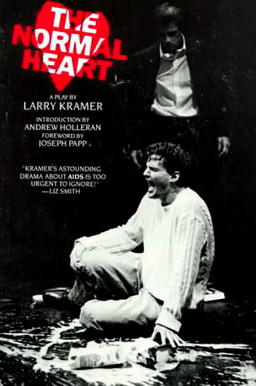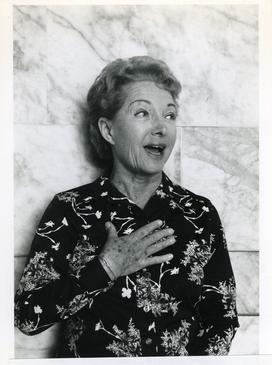Related Research Articles

Ryan Wayne White was an American teenager from Kokomo, Indiana, who became a national poster child for HIV/AIDS in the United States after his school barred him from attending classes following a diagnosis of AIDS. As a hemophiliac, he became infected with HIV from a contaminated factor VIII blood treatment and, when diagnosed in December 1984, was given six months to live. Doctors said he posed no risk to other students, as AIDS is not an airborne disease and spreads solely through bodily fluids, but AIDS was poorly understood by the general public at the time. When White tried to return to school, many parents and teachers in Howard County rallied against his attendance due to unwarranted concerns of the disease spreading to other students and staff. A lengthy administrative appeal process ensued, and news of the conflict turned Ryan into a popular celebrity and advocate for AIDS research and public education. Surprising his doctors, Ryan White lived five years longer than predicted. He died on April 8, 1990, one month before his high school graduation.

The AIDS epidemic, caused by HIV, found its way to the United States between the 1970s and 1980s, but was first noticed after doctors discovered clusters of Kaposi's sarcoma and pneumocystis pneumonia in homosexual men in Los Angeles, New York City, and San Francisco in 1981. Treatment of HIV/AIDS is primarily via the use of multiple antiretroviral drugs, and education programs to help people avoid infection.

Gaëtan Dugas was a Québécois Canadian flight attendant and a relatively early patient with the human immunodeficiency virus (HIV), who once was widely misdescribed as "Patient Zero", accusing him of introducing HIV to the United States. This claim, a blatant misapplication from the results of a narrowly focused study, has been definitively proven incorrect.
Peter Adair was a filmmaker and artist, best known for his pioneering gay and lesbian documentary Word Is Out: Stories of Some of Our Lives (1977).

Robert Boyle "Bobbi" Campbell Jr. was a public health nurse and an early United States AIDS activist. In September 1981, Campbell became the 16th person in San Francisco to be diagnosed with Kaposi's sarcoma, when that was a proxy for an AIDS diagnosis. He was the first to come out publicly as a person with what came to be known as AIDS, writing a regular column in the San Francisco Sentinel, syndicated nationwide, describing his experiences and posting photos of his KS lesions to help other San Franciscans know what to look for, as well as helping write the first San Francisco safer sex manual.

The Normal Heart is a largely autobiographical play by Larry Kramer.
Theatre Rhinoceros, Theatre Rhino, or The Rhino is a gay and lesbian theatre based in San Francisco. Theatre Rhinoceros is the world's longest-running professional queer theatre company. It was founded in the spring of 1977 by Lanny Baugniet and his late partner Allan B. Estes, Jr.. The company name was based on the "Lavender Rhino," a media device popularized by the Boston gay community in the mid-70s. It was chosen as a mascot and symbol of the community because it is a mild and peace-loving creature until provoked. It is a non-profit theater company dedicated to the production of plays by and about gay and lesbian people.

Joseph Adolph Sonnabend was a South African physician, scientist and HIV/AIDS researcher, notable for pioneering community-based research, the propagation of safe sex to prevent infection, and an early multifactorial model of AIDS.

And the Band Played On is a 1993 American television film docudrama directed by Roger Spottiswoode. The teleplay by Arnold Schulman is based on the best-selling 1987 non-fiction book And the Band Played On: Politics, People, and the AIDS Epidemic by Randy Shilts, and is noteworthy for featuring both a vast historical scope, as well as an exceptionally sprawling cast.

Selma Kaderman Dritz was an American physician and epidemiologist who worked in San Francisco, California, where she began tracking the first known cases of Acquired Immune Deficiency Syndrome (AIDS) in the early 1980s.

And the Band Played On: Politics, People, and the AIDS Epidemic is a 1987 book by San Francisco Chronicle journalist Randy Shilts. The book chronicles the discovery and spread of the human immunodeficiency virus (HIV) and acquired immune deficiency syndrome (AIDS) with a special emphasis on government indifference and political infighting—specifically in the United States—to what was then perceived as a specifically gay disease. Shilts's premise is that AIDS was allowed to happen: while the disease is caused by a biological agent, incompetence and apathy toward those initially affected allowed its spread to become much worse.

How to Have Sex in an Epidemic: One Approach is a 1983 manual by Richard Berkowitz and Michael Callen, under the direction of Joseph Sonnabend, to advise men who have sex with men (MSM) about how to avoid contracting the infecting agent which causes AIDS. It was among the first publications to recommend the use of condoms to prevent the transmission of STDs in men having sex with men, and has even been named, along with Play Fair!, as one of the foundational publications in the advent of modern safe sex.

Walt Whitman Odets is an American clinical psychologist and author. He has written about the early development, psychological and social experiences of gay men and their communities. Odets' earlier writing focused on the lives of men living in and surviving the early AIDS epidemic. The spring 1996 issue of Positive Impact Journal called him "an important voice in the AIDS education and prevention arena." Odets's 1995 study, In the Shadow of the Epidemic: Being HIV-Negative in the Age of AIDS, was listed by The New York Times as among the "Notable Books of the Year 1995." Additionally, In the Shadow of the Epidemic was the No. 1 bestselling book purchased by gay men in the late fall of 1995, according to The Advocate, and was confirmed as a "Gay Bestseller of 1995" by the Feminist Bookstore News.

The San Francisco AIDS Foundation (SFAF) is a nonprofit organization dedicated to providing services for people with HIV/AIDS, with a mission to end the AIDS epidemic in the United States. They were founded in 1982, at the beginning of the AIDS epidemic. SFAF is one of the largest and oldest community-based AIDS service organizations in the United States. SFAF has an 87.67% overall rating, and a 97% accountability & transparency rating, at Charity Navigator.
Reggie Williams was an American AIDS activist, who fought for culturally relevant AIDS education and services for gay and bisexual men of color. Williams served as a board member for the National Association of Black and White Men Together and as the first executive director of the National Task Force on AIDS Prevention.
New York City was affected by the AIDS epidemic of the 1980s more than any other U.S. city. The AIDS epidemic has been and continues to be highly localized due to a number of complex socio-cultural factors that affect the interaction of the populous communities that inhabit New York.
Henry M. Tavera was an AIDS activist, artistic director, and archivist based in the Mission District of San Francisco, California; his 1979 move to the region put him at the forefront of the AIDS epidemic via his involvement in various HIV/AIDS service organizations as well as AIDS theatre. He also did work around Chicano Gay Activism and teaching/advising. Tavera died on February 27, 2000, at 56 years old from kidney cancer.

Leland Moss was an American theatre director, writer, and gay activist who died from AIDS at age 41.

Social and political activism to raise awareness about HIV/AIDS, as well as to raise funds for effective treatment and care of people with AIDS (PWAs), has taken place in multiple nations across the world since the 1980s. As a disease that began in marginalized populations, efforts to mobilize funding, treatment, and fight discrimination have largely been dependent on the work of grassroots organizers directly confronting public health organizations as well as politicians, drug companies, and other institutions.
The AIDS–Holocaust metaphor is used by AIDS activists to compare the AIDS epidemic to the Holocaust. The comparison was popularized by Larry Kramer and ACT-UP, especially the organization's French chapter, as a way to garner sympathy for AIDS sufferers and spur research into the disease. Although the comparison is now "commonly heard" with regard to AIDS, critics maintain that it is a form of Holocaust trivialization.